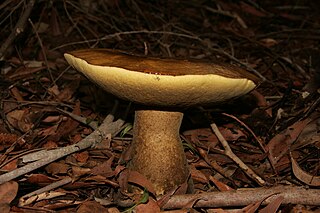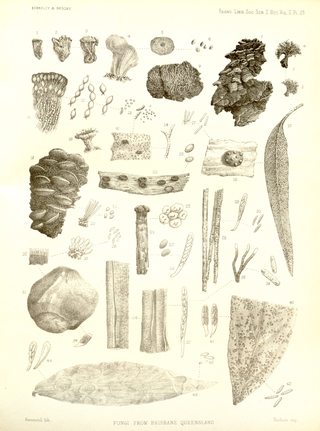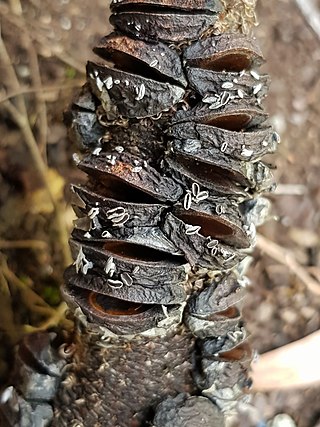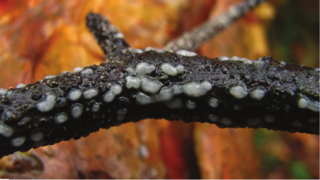
Phlebopus marginatus, commonly known as the salmon gum mushroom in Western Australia, is a member of the Boletales or pored fungi. An imposing sight in forests of south-eastern and south-western Australia, it is possibly Australia's largest terrestrial mushroom, with the weight of one specimen from Victoria recorded at 29 kg (64 lb). Initially described in 1845 as Boletus marginatus, and also previously known by scientific names such as Phaeogyroporus portentosus and Boletus portentosus, it is not as closely related to typical boletes as previously thought.

Omphalotus nidiformis, or ghost fungus, is a gilled basidiomycete mushroom most notable for its bioluminescent properties. It is known to be found primarily in southern Australia and Tasmania, but was reported from India in 2012 and 2018. The fan or funnel shaped fruit bodies are up to 30 cm (12 in) across, with cream-coloured caps overlain with shades of orange, brown, purple, or bluish-black. The white or cream gills run down the length of the stipe, which is up to 8 cm (3 in) long and tapers in thickness to the base. The fungus is both saprotrophic and parasitic, and its fruit bodies are generally found growing in overlapping clusters on a wide variety of dead or dying trees.

Gerronema is a genus of small- to medium-sized lignicolous agarics with white, nonamyloid, spores and decurrent gills. The genus was circumscribed by American mycologist Rolf Singer in 1951.

Panus conchatus, commonly known as the lilac oysterling, smooth panus, or conch panus, is an inedible species of mushroom that occurs throughout the Northern Hemisphere. Its fruitbodies are characterized by a smooth, lilac- or tan-colored cap, and decurrent gills. The fungus is saprophytic and fruits on the decomposing wood of a wide variety of deciduous and coniferous trees. Despite being a gilled species, phylogenetic analysis has shown it is closely related to the pored species found in the family Polyporaceae.

Banksiamyces is a genus of fungi in the order Helotiales, with a tentative placement in the family Helotiaceae. The genus contains four species, which grow on the seed follicles of the dead infructescences or "cones" of various species of Banksia, a genus in the plant family Proteaceae endemic to Australia. Fruit bodies of the fungus appear as small, shallow dark cups on the follicles of the Banksia fruit. The edges of dry fruit bodies fold inwards, appearing like narrow slits. The first specimens of Banksiamyces, known then as Tympanis toomansis, were described in 1887. Specimens continued to be collected occasionally for almost 100 years before becoming examined more critically in the early 1980s, leading to the creation of a new genus to contain what was determined to be three distinct species, B. katerinae, B. macrocarpus, and B. toomansis. A fourth species, B. maccannii, was added in 1984.

The Broomeiaceae are a family of fungi in the order Agaricales. The family is monotypic, and contains the single genus Broomeia, described by English naturalist Miles Joseph Berkeley in 1844, and named for his collaborator, Christopher Edmund Broome. Berkeley designated the type species to be Broomeia congregata. Species of this fungus family can be found in Mexico as well as various parts of Africa.

Hygrophoropsis is a genus of gilled fungi in the family Hygrophoropsidaceae. It was circumscribed in 1888 to contain the type species, H. aurantiaca, a widespread fungus that, based on its appearance, has been affiliated with Cantharellus, Clitocybe, and Paxillus. Modern molecular phylogenetic analysis shows that the genus belongs to the suborder Coniophorineae of the order Boletales.
Episphaeria is a genus of fungus in the Agaricales. The genus is monotypic, and contains the single rare species Episphaeria fraxinicola, found in Europe. Its familial position is not known with certainty. The tiny fruit bodies of the fungus resemble minute, white cups that grow scattered or in groups on the bark of ash trees.

Amanita ceciliae, commonly called snakeskin grisette, strangulated amanita, and the Cecilia's ringless amanita, is a basidiomycete fungus in the genus Amanita. First described in 1854 by Miles Joseph Berkeley and Christopher Edmund Broome, it was given its current name by Cornelis Bas in 1984. It is characterized by bearing a large fruit body with a brown cap 5–12 cm (2.0–4.7 in) across. The cap has charcoal-grey patches, which are easily removable. The stipe is 7–18 cm (2.8–7.1 in) long, white in colour, and there is no ring on it. It is slightly tapered to the top, and has irregular cottony bands girdling the base. The universal veil is grey. Spores are white, spherical in shape, non-amyloid, and measure 10.2–11.7 micrometres. The mushrooms are considered edible, but field guides typically advise caution in selecting them for consumption, due to risks of confusion with similar toxic species. A. ceciliae is found in woods throughout Europe and North America, where it fruits during summer and autumn.

Banksiamyces toomansis is a species of fungus in the family Helotiaceae. It was first described as Tympanis toomansis by Miles Joseph Berkeley and Christopher Edmund Broome in 1886, and transferred to the genus Encoelia in 1957 by R.W.G. Dennis. Gordon William Beaton transferred it to Banksiamyces in 1982.
Gerronema viridilucens is a species of agaric fungus in the family Porotheleaceae. Found in South America, the mycelium and fruit bodies of the fungus are bioluminescent.

Clavulinopsis umbrinella, commonly known as the beige coral, is a coral mushroom in the family Clavariaceae. Fruit bodies are initially white before turning pale brown with darker brown tips. Originally described in 1860, it is known to occur in Europe and North America where it grows in grass. It is not a common species.

Discinella terrestris is a species of fungus in the family Helotiaceae. It was first described as Helotium terrestre by Miles Joseph Berkeley and Christopher Edmund Broome in 1882, from collections made in Brisbane. R.W.G. Dennis transferred it to the genus Discinella in 1958.

Phillipsia subpurpurea is a species of fungus in the family Sarcoscyphaceae. It is found in Australia where it grows as a saprophyte on wood. The fungus was first described scientifically by English mycologists Miles Joseph Berkeley and Christopher Edmund Broome. Its cup-shaped fruit bodies lack stipes and have purplish interior surfaces.
Roy Watling, PhD., DSc, FRSE, F.I.Biol., C.Biol., FLS is a Scottish mycologist who has made significant contributions to the study of fungi both in the identification of new species and correct taxonomic placement, as well as in fungal ecology.

Sarcodon thwaitesii is a species of tooth fungus in the family Bankeraceae. It is found in Asia, Europe, and New Zealand, where it fruits on the ground in mixed forest.
Merulius berkeleyi is a species of fungus in the family Meruliaceae. It is found in Sri Lanka.
Ruth Ellen Berkeley was an English mycologist, collector of fungi specimens and scientific botanical illustrator. She is known for her specimen collections as well as her illustrations of British fungi particularly in Mordecai Cubitt Cooke's book Illustrations of British Fungi (Hymenomycetes). Her father, the mycologist Miles Joseph Berkeley, named a fungal species Agaricus ruthae in her honour.

Naohidea sebacea is a species of fungus in the order Naohideales. The order is currently monotypic, having only one family, one genus, and one species. Basidiocarps of Naohidea sebacea form small, gelatinous pustules on wood-inhabiting species of Botryosphaeriaceae. Microscopically, they produce long, slender, auricularioid basidia and amygdaliform (almond-shaped) basidiospores.













